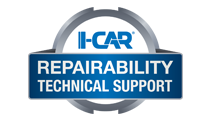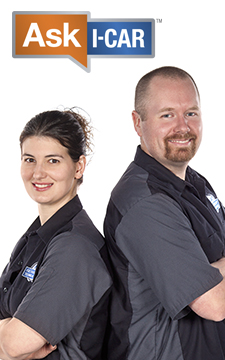OEM Restraints System Part Replacement Search
2013 Toyota Prius Plug In
Share:
|
DISABLE PROCEDURE AND TIME (Always Check Service Manual)
Before using an electric welder on the vehicle, remove any SRS parts around the area beingrepaired.
NOTICE:
After turning the ignition switch off, waiting time may be required before disconnecting the cable from the negative (-) battery terminal. See the navigation note below.
1. Turn ignition switch to OFF
2. Disconnect the negative (-) auxiliary battery terminal
3. Wait at least 90 seconds.
After the ignition switch is turned off, the navigation receiver assembly (for Navigation Receiver Type) or radio and display receiver assembly (for Radio and Display Type with Intuitive Parking Assist System) records various types of memory and settings. As a result, after turning the ignition switch off, make sure to wait at least 60 seconds before disconnecting the cable from the negative (-) battery terminal
REV: 12/2014
PARTS THAT MUST BE REPLACED FOLLOWING A DEPLOYMENT
When the SRS parts are deployed (including when only an airbag or pretensioner is deployed) due to a collision, be sure to replace all sensors in the damaged areas (anywhere in need of repair) and and airbag ECU assembly.• Horn button assembly [AIRBAG,STEERING WHEEL], [if deployed]
• Lower No. 1 instrument panel airbag assembly [AIRBAG,KNEE BOLSTER], [if deployed]
• Instrument panel passenger airbag assembly [AIRBAG,INSTRUMENT PNL], [if deployed]
• Curtain shield airbag assemblies [AIRBAG,ROOF], [if deployed]
• Front seat airbag assemblies [AIRBAG,FRONT SEAT] If the side airbag was deployed, replace the front seat airbag assembly, separate type front seatback spring assembly, separate type front seatback cover and separate type front seatback pad with the necessary parts in accordance with the extent of the collision damage.
• Airbag ECU assembly [MODULE,AIRBAG CONTROL]
When the SRS parts are deployed (including when only an airbag or pretensioner is deployed) due to a collision, be sure to replace all sensors in the damaged areas (anywhere in need of repair):
• Front airbag sensors [AIRBAG SENSOR,FRONT]
• Side airbag sensor assemblies [AIRBAG SENSOR,FRT DOOR; AIRBAG SENSOR,SIDE]
• Side No. 2 airbag sensor assemblies [AIRBAG SENSOR,QTR PANEL]
PARTS THAT MUST BE INSPECTED AND REPLACED IF DAMAGED
When troubleshooting the SRS, always inspect DTCs before disconnecting the battery• Horn button assembly [AIRBAG,STEERING WHEEL]
• Lower No. 1 instrument panel airbag assembly [AIRBAG,KNEE BOLSTER]
• Instrument panel passenger airbag assembly [AIRBAG,INSTRUMENT PNL]
• Curtain shield airbag assemblies [AIRBAG,ROOF]
• Front seat airbag assemblies [AIRBAG,FRONT SEAT]
• Front seat outer belt assemblies
• Airbag ECU assembly [[MODULE,AIRBAG CONTROL]]
• Front airbag sensors [AIRBAG SENSOR,FRONT]
• Door side airbag sensors [AIRBAG SENSOR,FRT DOOR]
• Side airbag sensor assemblies [AIRBAG SENSOR,SIDE]
• Side No. 2 airbag sensor assemblies [AIRBAG SENSOR,QTR PANEL]
Additionally inspect the:
• Steering wheel
• Instrument panel or Instrument panel reinforcement
• Front pillar garnish and Headliner
Replace any faulty parts of the seat belt systems (outer belt, inner belt, bolts, nuts, adjustable shoulder anchor, tether anchor hardware and other related parts). When inspecting a vehicle that was in a collision, be sure to check all of the seat belt systems regardless of whether or not the system was activated in the collision. Replace any damaged or malfunctioning systems.
| Additional Information |
*This matrix does not currently contain all production vehicles sold in the United States. The contents were developed in cooperation with AudaExplore, a Solera company. The contents are based on the information available at the time of publication. Updates and additions will be posted as they become available. To ensure that you are using the most recent information, always refer to vehicle maker technical information.









